

Great Lessons 1: Probing. Introduction In all the talk of improving teaching and learning, sometimes – no often – there is too much talk about the model OfSTED lesson.

Too often this leads teachers into thinking of idealised lessons than can only be turned out in special circumstances or that Outstanding lessons require us to devise an elaborate box of tricks to show off with. However, as I have said elsewhere,it is the 99% of lessons that are never observed that really matter. So, we need to focus on things that we do every day. Two related ideas: 1) It is the spirit of an idea that is important, not the letter. 2) In improving as teachers, we are not collecting tools, we seeking to change our habits… the things we do automatically every day.
John Sayers Geography Blog: Questioning. The start of a new term is nearly upon us and I am going in revitalised due to a number of life changes.
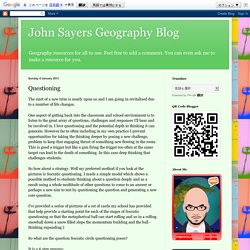
One aspect of getting back into the classroom and school environment is to listen to the great array of questions, challenges and responses I'll hear and be involved in. I love questioning and the potential depth to thinking it can generate. However far to often including in my own practice I prevent opportunities for taking the thinking deeper by posing a new challenge, problem to keep that engaging thrust of something new flowing in the room.
This is good a trigger but like a gun firing the trigger too often at the same target can lead to the death of something. Letting Students Lead the Learning. Student-led independent learning is central to my beliefs as a teacher.
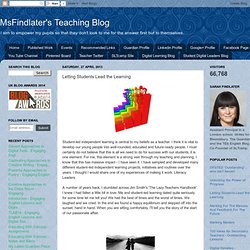
I think it is vital to develop our young people into well-rounded, educated and future-ready people. Why I think SOLO taxonomy will help my Year 13s. Now, readers, I am assuming you have heard of SOLO taxonomy.

If you haven’t, I recommend you check out this website from Pam Hook, or this blog from David Didau, or this blog from Tait Coles. When you’ve done that come back again. I started to hear about SOLO taxonomy mid way through my second PGCE placement, when a bunch of people I follow on Twitter started talking about it. “Selling” SOLO Taxonomy to Staff « krystaljem. On my Independence Teaching journey the next academic year is the move from encouraging my students within my own classroom to expanding independence whole school.

With six school teacher training sessions based on encouraging our students to be independent and resilient learners; I really want to provide training that is not only interactive but shows the importance of this initiative for our students. I need to be able to transfer my passion for this topic to teachers: a breed that even by our own admittance can be resistant to change [especially as we are constantly being asked to change from one initiative to another by government, theorists and schools too!] But first I have a training session to run the first week back for ASTs and excellent teachers based on SOLO Taxonomy. I have scoured books, blogs and Twitter for ideas and ways into introducing SOLO in as active and convincing way as possible. Here is my plan for the session – any comments or improvements would be welcomed.
- Home. Small fish in the big sea of blogging. Towards Co-constructed Learning: How to get it started. Having written about co-construction in our Learning Lessons publication (Vol 2/ Issue 8 and Vol 3/ Issue 3), also profiled in this post I was invited to run some CPD sessions in two schools and then to write a summary of the process.
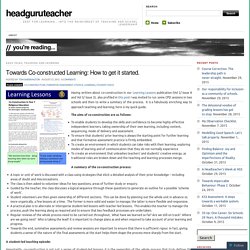
It is a fabulously enriching way to approach teaching and learning; here is my quick guide. The aims of co-construction are as follows: A summary of the co-construction process: A topic or unit of work is discussed with a class using strategies that elicit a detailed analysis of their prior knowledge – including areas of doubt and misconceptions.The class is then asked to volunteer ideas for key questions, areas of further study or enquiry.Guided by the teacher, the class discusses a logical sequence through these questions to generate an outline for a possible ‘scheme of work’.Student volunteers are then given ownership of different sections.
This can be done by planning out the whole unit in advance or, more organically, a few lessons at a time. "Miss....atoms are made of protons, croutons, and electrons right?" Sharing SOLO with students. One of the questions that I have been asked a lot lately from either colleagues or Tweachers is 'How do you actually introduce SOLO taxonomy to students?

' Many of the people I chat to obviously have caught the bug and want to take it further in their lessons but had the same cautious questions that I did to begin with. Once you get your own head around SOLO, the terminology, symbols, resources and activities all make perfect sense. But it's getting your head around it that's the worry, and even more so for students. Sharing Pedagogical Purposes. Teaching, Learning, Education: SOLO, Bloom's - Time to Think! I have been awash with Twitter enthusiasm for #SOLO; lot's of teachers are keen to describe the benefits of helping pupils improve their metacognitive self-awareness.
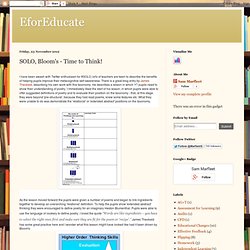
There is a great blog entry by James Theobald, describing his own work with this taxonomy. He describes a lesson in which Y7 pupils need to show their understanding of poetry. I immediately liked the start of his lesson, in which pupils were able to offer suggested definitions of poetry and to evaluate their position on the taxonomy - that, at this stage, they were beyond 'pre-structural', because they had read poems, knew some features etc. What they were unable to do was demonstrate the 'relational' or 'extended abstract' positions on the taxonomy. Looking beyond a lesson in SOLO. Now I have been using SOLO in my GCSE PE classes since April 2012.
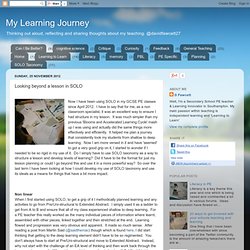
I have to say that for me, as a non classroom specialist, it was an excellent way to ensure I had structure in my lesson. It was much simpler than my previous 'Blooms and Accelerated Learning Cycle' mash up I was using and actually did the same things more effectively and efficiently.
Learner Evolution ~ Chris Harte: #feedforward. The more I think about assessment, the more fascinating and intricate I find it.
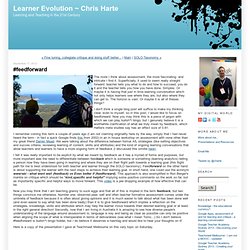
Superficially, it used to seem really straight forward; teacher tells you what to do and how to succeed, you do it and the teacher tells you how you have done. Simples. Or maybe it is having that just in time learning conversation which not only helps learners see where they are, but also where they can get to. The horizon is vast. Flipping Learning: Some useful tools. In my last effort to enthral the blogosphere with my own low-level version of "expertise"(and from your kind comments back I seem to have succeeded in managing everyone's expectations downwards remarkably well!) , I talked about my journey into the idea of "flipping the classroom". It was all very abstract and you missed nothing much, although in fairness you should really read it again before this post, if only to give my stats a boost: Zero is a lonely little readership figure.
Today I thought I'd get concrete on your asses, and give you some idea of the sorts of things I do in class to flip the learning. These could be regarded as fairly subject-specific, but I think the principles are applicable in a range of areas, or so I'm informed by reliable colleagues. More reliable than me at any rate. Letter to a Friend « Reflective Teacher and Learner. Is there a right way to teach? It’s become a trite and hackneyed truism that if they’re not learning you’re just talking. We’re all clear that teaching only happens when the little tinkers manage to make some sort of progress – preferably that of the rapid and sustained variety. But this simple truth, like so many others, seems to have been systematically and catastrophically misunderstood by many school leaders and inspectors.
Until recently it was universally accepted that the key to a good lesson observation was showing that pupils are making progress in the 25 minutes available to us, and that the only way we could demonstrate this progress was by shutting the hell up and letting the kids do some work. If a teacher was observed speaking to the whole class they’d be exposed as being a bit rubbish and fast tracked on to the capability process. By Josie and Emily. Punk Learning – I want to be free, free to learn to be me. “Well I hate to go to school and listen to the stupid rules. Just to keep me out of the way. So they can have an easy day. Making Feedback Count: “Close the Gap” Recently I have been looking again at the issue of marking. It is a hugely important source of feedback provided that we keep the volume of marking in proportion to the level of impact it can have in improving learning outcomes. I’ve discussed this in a much-read earlier post: Marking in Perspective: Selective, Formative, Effective, Reflective.
At a whole school level at KEGS and in my own department, a key objective for the year is to devise approaches to marking that deliver maximum impact for all to see – that ‘progress over time’ issue. What does marking look like when it is clearly securing improvement and progress in learning? Marking time again. Post-it hexagons. Jig-sawing new information « The challenge I have set myself, as I mentioned in the last post is overcoming a didactic culture of learning and getting students to embrace group and independent study.
Whenever I have observed really good lessons in other subjects they often have one thing in common: a kind of symmetry in terms of activity, simplicity and results. The most well-rounded of group work techniques is jigsaws. Today I tried this with factors affecting hydrographs. Ideas in a mixed up world of tradition and tech. No longer Bullet Proof « stilllearing. This was the week I discovered I wasn’t bullet proof. My NQT year has had its highs and lows during the last twelve months, but nothing that has laid me low or given me too much that I couldn’t resolve it. - Home. Resources - @Ideas_Factory The blog of Julian S. Wood. With the new changes to the ICT curriculum in England for 2014, I decided to collate all the Computing links that I can in this one handy space.
Suggestions welcome. Excellent guide to new Computing Curriculum from NAACE and CAS written by Miles Berry (@MBerry) Amazing Book by @SimonHaughton (Very good for adults too! Purple Elf's Learning Adventures. Outstanding teaching using the new #Ofsted framework « @ TeacherToolkit. Firstly, this is not a model, just an experience… Ofsted background: …Throughout my teaching career, I’ve been part of 5 Ofsted inspections, dating back to 1997 as a class teacher, and most recently in 2011, my second as a senior teacher… When starting my current school, Oftsed had departed the day before!
My wife, after 11 years of teaching has only been ‘subject to Ofsted’ once, but I’m sure some teachers across the country have averaged one every 2 or 3 years! My average is every 4… On each of the occasions I have ‘been done to’, the framework has changed and so has the experience; alternating from reply-slips and no-comments from the observing inspector, to a broad smile, coupled with detailed feedback and a reciprocated pair of ears. The experience in all, has been a mixed-bag, full of dread and of interest… AHOTT6 July 2012. Cultural ties… This has been a hard week for the children in the support group.
One of them, who had been doing well back in class, has been very disruptive again lately. He poked his head round my door one morning at breakfast club, looked at me with a wry smile, and asked if he could return to the group as he wasn’t managing and didn’t want to disrupt the other pupils. #blogsync - an Initiative in UK Teacher Blog Synchronisation - EDUTRONIC. Teaching Science: 5Es. The 5Es are engage, elicit, explore, explain, elaborate. What are you marking that for? Teaching Science: What is the lesson about? My current favourite starter activity is "What is the lesson about? ". Meridianvale. The Myth of Progress Within Lessons « kevenbartle's Blog.